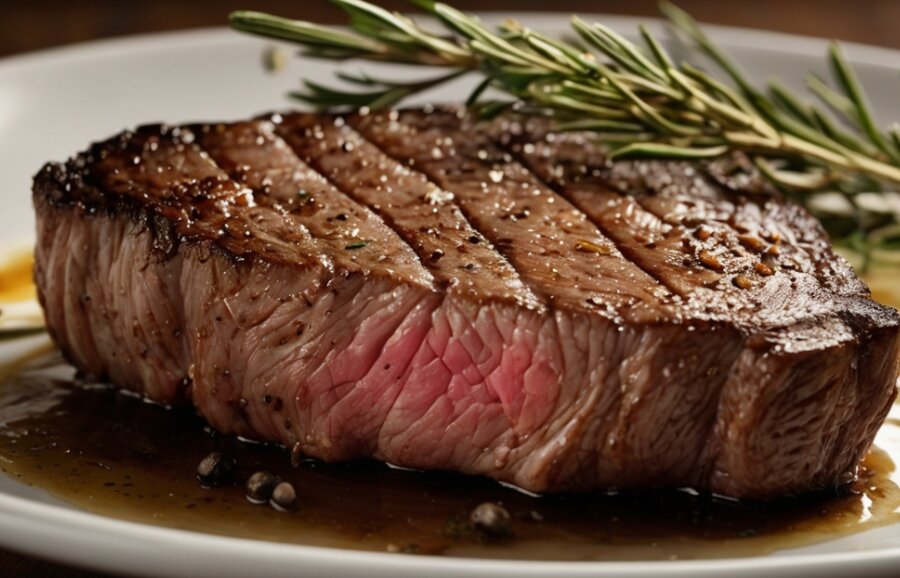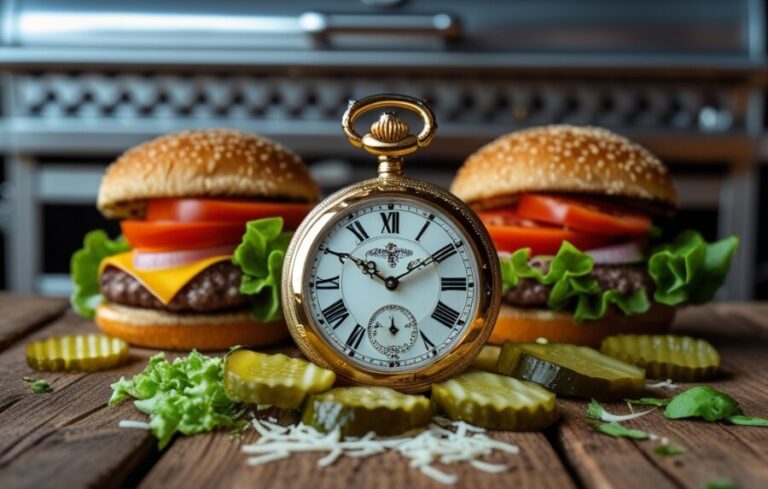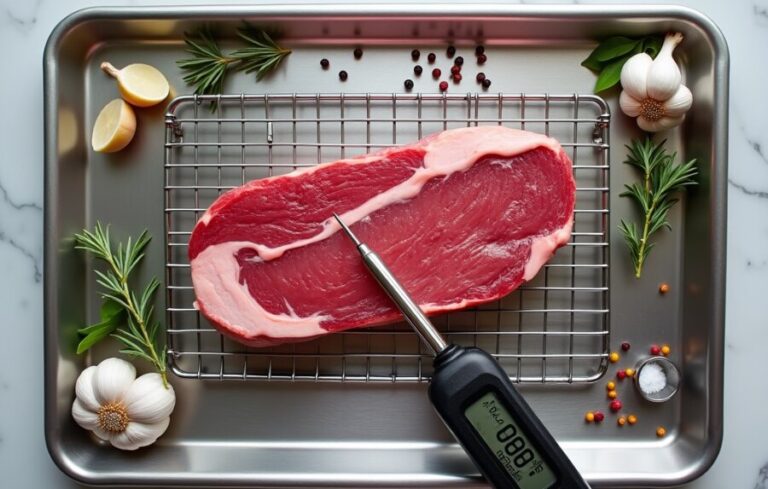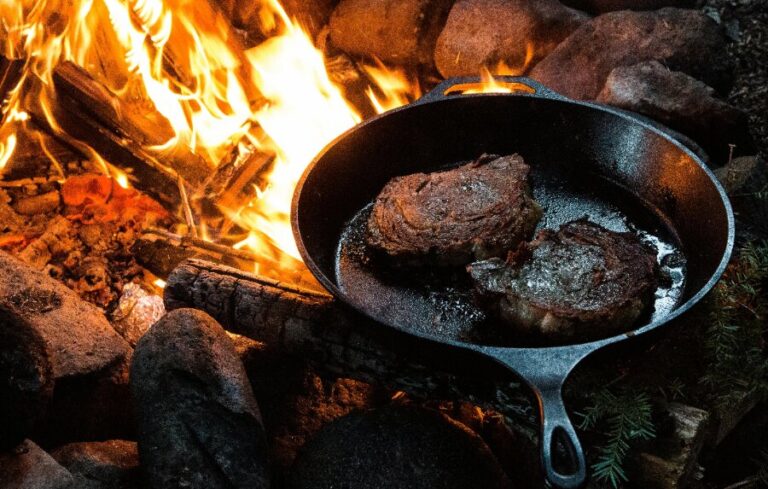Our evaluations and product assessments are conducted using a thorough and unbiased approach. Should you choose to buy any items through our provided links, we might receive a commission Read our disclosures.
Nailing the Reverse Sear Method
What is Reverse Searing?
A reverse sear steak recipe is a straightforward two-step way to get perfectly cooked meat. Start by cooking the steak slowly at a low temp, somewhere between 200°F and 275°F. This gentle approach makes sure your steak is tender, juicy, and cooked evenly all the way through. Once the steak hits the right internal temperature, crank up the heat and sear it in a hot pan, like a trusty cast-iron skillet. This part gives you that mouth-watering crispy crust everyone loves.
This technique rocks for thick steaks, think filet mignon, New York strip, or ribeye. Anything 1 ½ inches or thicker works best. Slow-cooking in the oven not only makes the steak tender but also lets natural enzymes break down those tough muscle fibers, giving you a softer bite.
Why Reverse Searing is Awesome
Reverse searing isn’t just some fancy chef trick; it’s your secret weapon for steak goodness. Here’s why it’s a game-changer:
| Perk | What It Means |
|---|---|
| Even Cooking | Slow and steady cooking makes sure your steak is perfectly done from edge to edge, no more burnt outsides and raw insides. |
| Amazing Sear | Searing at the end means you get a perfect crust without losing any of that juiciness inside. |
| Juicier Steak | This method keeps more moisture in, so every bite is tender and flavorful. |
Ready to give it a shot? Check out my step-by-step guide on how to reverse sear a steak. Whether you’re grilling for a casual weekend or showing off at a barbecue, mastering reverse searing will take your steak game to the next level.
Nailing the Perfect Steak
So, you want to master the reverse sear steak recipe? Great choice! Picking the right cut is your first step towards steak nirvana. This method is a game-changer for thick, juicy cuts that need a slow cook followed by a hot sear. Ready to dig in?
Best Steak Cuts
When using the reverse sear method, go for steaks at least 1.5 inches thick. Here’s a quick guide:
| Steak Cut | Why It Rocks |
|---|---|
| Filet Mignon | Tender with a buttery flavor |
| New York Strip | Rich in marbling and texture |
| Porterhouse | Get filet and strip in one |
| Ribeye | Juicy with loads of flavor |
| T-Bone | Two cuts for the price of one |
| Tomahawk Steak | Big, bold, and delicious |
| Tri-Tip | Grills up beautifully |
These cuts are made for the reverse sear—offering even cooking and killer flavor. Thin cuts like minute steaks? They just won’t cut it (pun intended!).
Get the Thickness Right
Thickness matters. For the best results, your steak should be at least 1.5 inches thick. Here’s why:
| Thickness | Good for Reverse Sear? |
|---|---|
| Less than 1 inch | Nope |
| 1 inch | Meh, not really |
| 1 ½ inches | Absolutely |
| 2 inches | Perfecto |
| 3 inches or more | Steak heaven |
Anything over 1.5 inches is golden. You can even go full-on with a prime rib roast and still nail it using the reverse sear. For more tips and tricks on this method, check out my guides on reverse sear sous vide and reverse sear cast iron. Happy cooking!
Making a Perfect Reverse Seared Steak
Turning out a killer steak with a scrumptious crust through the reverse sear method isn’t hard, but hitting the right steps is a must. Here’s my playbook.
Getting Your Steak Ready
First off, yank that steak from the fridge and let it chill on the counter for about 30 to 60 minutes. The goal? Room temp steak cooks way more evenly. Then, sprinkle on some salt and pepper—don’t skimp.
Cooking steak in the oven at 275°F triggers natural cathepsin enzymes. These little guys work wonders by tenderizing your meat and breaking down muscle proteins (Jessica Gavin). What you get is meat that’s both flavorsome and tender.
Slow-Cook Magic
Lay the seasoned steak on a rack over a sheet pan and slide it into an oven preheated to 275°F. The baking time depends on how thick your steak is and how done you want it.
| Steak Thickness | Approximate Time |
|---|---|
| 1 inch | 15-20 minutes |
| 1.5 inches | 20-25 minutes |
| 2 inches | 25-30 minutes |
Once the steak hits an internal temp about 10-15°F short of your ideal doneness, pull it out and let it rest for a sec while you gear up the skillet.
Nailing the Sear
The fun bit—searing. Crank up your stove and preheat a skillet (stainless steel or cast iron works best) on high heat. Give it around 2 minutes so it’s blazing hot before you toss the steak in.
Pour in some oil with a high smoke point like vegetable or canola, then lay the steak in the pan. A good sear takes about 1 to 2 minutes per side to lock in that rich, brown crust. No crowding the skillet, or you’ll end up steaming rather than searing.
After searing, give it a few moments to rest. This lets the juices move back into the meat, making for a succulent bite every time. For more tips, check out my write-up on the reverse sear steak method.
Now go forth, and get cooking!

Tips to Nail on a Reverse Sear Steak
When I’m going for that perfect reverse sear steak, here’s what I always remember to get the job done just right every time.
Nailing the Seasoning
First off, you gotta season it up, big time. For me, kosher salt and fresh ground black pepper are the go-to. This combo isn’t fancy, but it packs a big punch, bringing out a deep, savory flavor that crusts up nicely. It’s like adding a magic touch to the meat, promising a juicy, flavorful bite every time (Jessie Bernhardt).
Don’t Forget to Rest It
Here’s a step you can’t skip: letting that steak chill for at least 10 minutes post-cook. This makes sure all those tasty juices settle back into the meat instead of leaking out when you slice it. The result? A steak that’s juicy and full of flavor, worth the short wait.
Meat Thermometer is Your Best Friend
Another must-have is a meat thermometer. It’s all about hitting that sweet spot with the internal temperature. I usually pull the steak off the heat when it’s 3-5 degrees shy of where I want it because it’ll keep cooking a bit as it rests. Here’s a handy chart for those target temps (Jess Pryles):
| Doneness | Temperature (°F) |
|---|---|
| Rare | 120-125 |
| Medium Rare | 130-135 |
| Medium | 140-145 |
| Medium Well | 150-155 |
| Well Done | 160+ |
With these tips, plus a solid guide on reverse searing a steak, you’re well on your way to restaurant-quality steaks right at home. And if you’re feeling adventurous, try mixing it up with reverse sear sous vide or reverse sear cast iron.
Spice Up Your Reverse Searing Game
Wanna up your steak game? Let’s talk about different ways to nail the reverse sear technique, from sticking to the basics to trying something that’ll make your taste buds dance. Here’s the lowdown on cooking methods and timing tricks.
Cool Ways to Cook
Reverse sear isn’t just a fancy name—it’s your ticket to steak heaven. Besides the trusty old oven, there are other methods that turn your steak into a restaurant-level experience:
| Cooking Method | What’s the Deal? |
|---|---|
| Oven Baking | Pop your steaks in at 275°F for 15-25 minutes. This slow bake makes sure your meat cooks evenly. (Jessica Gavin) |
| Sous Vide Magic | Submerge your steaks in a water bath for that perfect tenderness, then sear ’em up. For details, check my take on the reverse sear sous vide. |
| Cast Iron Sizzle | Let a cast iron skillet work its magic. Slow cook then crank up the heat for a sear. It distributes heat like a champ and crafts an awesome crust. More on this in my reverse sear cast iron guide. |
Mixing up your methods can surprise your taste buds with new flavors and textures each time.
Timing and Temperature Tips
Getting the timing and temperature right is key. Here’s your cheat sheet:
| Doneness | Oven Temp | Cook Time | Sear Time |
|---|---|---|---|
| Rare | 125°F | 20-25 min | 1 min each side |
| Medium-Rare | 135°F | 15-20 min | 1-2 min each side |
| Medium | 145°F | 12-15 min | 2 min each side |
| Medium-Well | 150°F | 10-12 min | 2-3 min each side |
| Well-Done | 160°F | 8-10 min | 3 min each side |
Cooking your steak slow in the oven makes it juicy and tender. Then, searing it at the end locks in all that flavor with a mouth-watering crust (Serious Eats).
Always use a meat thermometer to nail the perfect internal temperature. Master the reverse sear steak method and enjoy every bite!
Fine-Tuning Your Steak Game
Thicker Cuts Mean Better Flavor
Alright, let’s get to the meat of the matter. If you want to nail the reverse sear technique, go thick or go home. We’re talking steaks at least 1.5 inches thick. Think of beautiful cuts like filet mignon, New York strip, porterhouse, ribeye, T-bone, tomahawk, or tri-tip. These cuts offer that magical combo of a crispy char on the outside and juicy, flavorful goodness on the inside. As Jessica Gavin mentions, this method works wonders for these thick cuts because they hold onto their moisture and become tender as butter.
Here’s a little cheat sheet for you:
| Steak Cut | Recommended Thickness |
|---|---|
| Filet Mignon | 1.5 inches and up |
| New York Strip | 1.5 inches and up |
| Ribeye | 1.5 inches and up |
| Porterhouse | 1.5 inches and up |
| Tomahawk | 2 inches and up |
| Tri-tip | 1.5 inches and up |
Bigger beasts like a whole prime rib roast? They’re just begging for the reverse sear treatment (Jess Pryles). Now, give those wafer-thin steaks the boot – the reverse sear is not their friend.
Nail That Perfect Doneness
You gotta know how to hit your desired doneness, or else you’re just grilling meat. For a medium-rare steak, you should be aiming for an internal temp of around 135°F after searing. The USDA says medium-rare is a cool 130-135°F, which gives you that perfect pink center. Cook at 450°F for about 5 to 7 minutes per side (Traeger).
A trusty meat thermometer is your BFF here. Pull the steak off the heat when it’s a few degrees shy of your target – like 3-5 degrees under – and let it rest. It’ll keep cooking a bit on its own (Jess Pryles). That way, it’s perfectly done by the time you slice into it.








